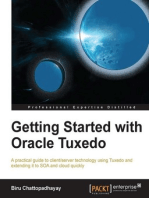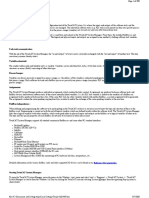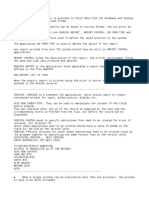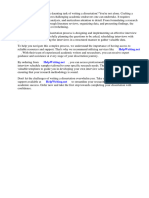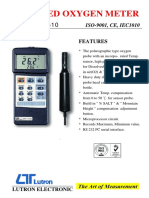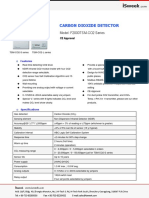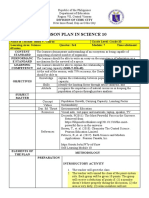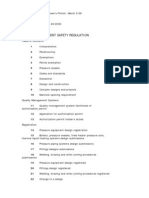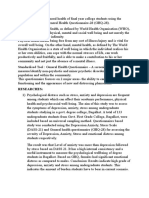Professional Documents
Culture Documents
Tuxedo
Tuxedo
Uploaded by
Predrag TerzicOriginal Description:
Copyright
Available Formats
Share this document
Did you find this document useful?
Is this content inappropriate?
Report this DocumentCopyright:
Available Formats
Tuxedo
Tuxedo
Uploaded by
Predrag TerzicCopyright:
Available Formats
TUXEDO
http://download.oracle.com/docs/cd/E13203_01/tuxedo/tux80/interm/admin.htm
1. Create and edit the UBBCONFIG file (a text version of TUXCONFIG) with a text editor. 2. Run tmloadcf to convert the UBBCONFIG file into a TUXCONFIG (binary) file. Before tmloadcf is executed, the environment variable TUXCONFIG must be set to the full pathname of the device or system file where TUXCONFIG is to be loaded.
Contents of the Configuration File
The following table lists the nine sections of the configuration file and describes the purpose of each section. Required or Optional Required Required Optional Optional Purpose Defines all system parameters. Specifies all the machines in your application. Defines all groups, group names, and group IDs for your application. Specifies the initial conditions for servers started in the system. Provides information on services used by the application. For CORBA environments, provides information on application-wide, default parameters for interfaces used by the application. Describes the network configuration for a LAN environment. Describes the network groups available to the application in the LAN environment. Provides information for data-dependent routing of service requests using FML buffers and views.
Section MACHINES GROUPS SERVERS SERVICES
RESOURCES Required
INTERFACES Optional
NETWORK
Optional
NETGROUPS Optional ROUTING Optional
How to find out the total number of users connected
If you use TUXEDO's tmadmin command and then use 'printclient' from the prompt, you'll be able to see the number of TUXEDO connections for both types of clients.
What Is the Workstation Component?
The Workstation component of the BEA Tuxedo system allows application clients to reside on a machine that does not have a full server-side installation, that is, a machine that does not support any administration or application servers. All communication between the client and the application servers takes place over the network.
A Workstation client process can run on a Windows 98, Windows 2000, or UNIX platform. The client has access to the ATMI. The networking behind requests is transparent to the user. The Workstation client registers with the system through a Workstation handler (WSH) and has access to the same capabilities as a native client. All communication between a Workstation client and application server is done through a Workstation handler (WSH) process. Workstation clients can perform almost all the same functions that can be performed by network clients. They can, for example: Send and receive messages Begin, end, or commit transactions Send and receive unsolicited messages Take full advantage of any security mechanism offered to BEA Tuxedo clients
How to Compile a Configuration File
Compiling a configuration file means generating a binary version of the file (TUXCONFIG) from the text version (UBBCONFIG). To compile a configuration file, run the tmloadcf command. tmloadcf parses a UBBCONFIG file and loads the binary file. tmloadcf reads a file (or standard input written in UBBCONFIG syntax), checks the syntax, and optionally loads a binary configuration file called TUXCONFIG. The TUXCONFIG and (optionally) TUXOFFSET environment variables point to the TUXCONFIG file and (optional) offset where the information should be stored. You can run tmloadcf only on the machine designated as MASTER in the RESOURCES section of the UBBCONFIG file, unless the -c or -n option is specified. Notes: The user identifier (UID) of the person running tmloadcf must match the UID, if specified, in the RESOURCES section of the UBBCONFIG file. The pathname specified for the TUXCONFIG environment variable must match exactly (including case) the pathname specified for TUXCONFIG parameter within the MACHINES section of the UBBCONFIG file. Otherwise, tmloadcf(1) cannot be run successfully.
Using Log Files to Monitor Activity
To help you identify error conditions quickly and accurately, the BEA Tuxedo system provides the following log files: Transaction log (TLOG)a binary file that is not normally read by you (the administrator), but that is used by the Transaction Manager Server (TMS). A TLOG is created only on machines involved in BEA Tuxedo global transactions. User log (ULOG)a log of messages generated by the BEA Tuxedo system while your application is running.
These logs are maintained and updated constantly while your application is running.
You might also like
- Lockie LeonardDocument5 pagesLockie Leonardmiracle.ogbonna952No ratings yet
- Navigator Huawei Optix Osn Equipment Command Line Introduction 20080628 ADocument48 pagesNavigator Huawei Optix Osn Equipment Command Line Introduction 20080628 AAlceuCarneiro50% (2)
- Comandos Navigator HuaweiDocument49 pagesComandos Navigator HuaweiClaudio Saez50% (4)
- BSCS Rating DocumentDocument19 pagesBSCS Rating Documentnagesh100% (1)
- Comfortably Numb Tab by Pink FloydDocument6 pagesComfortably Numb Tab by Pink FloydmorbidpaleNo ratings yet
- Ftbs 2Document416 pagesFtbs 2pegla1977No ratings yet
- RTU C50 BDocument4 pagesRTU C50 BijaxkribsNo ratings yet
- NCPCOMCommanderUserManualv1 0Document12 pagesNCPCOMCommanderUserManualv1 0Ross SheNo ratings yet
- TC Automation InterfaceDocument475 pagesTC Automation InterfaceFabio Roberto GambaNo ratings yet
- Dynamic Modelling Tips and TricksDocument20 pagesDynamic Modelling Tips and TricksmkwendeNo ratings yet
- SRS - How to build a Pen Test and Hacking PlatformFrom EverandSRS - How to build a Pen Test and Hacking PlatformRating: 2 out of 5 stars2/5 (1)
- 26 Pycnogenol EbookDocument36 pages26 Pycnogenol EbookPredrag TerzicNo ratings yet
- Farm Structure NotesDocument150 pagesFarm Structure NotesAnnebo Tayebwa96% (26)
- Tuxedo IntroDocument31 pagesTuxedo IntroMishra UmashankarNo ratings yet
- Manual TuxedoDocument6 pagesManual TuxedoAlexander Rafael Suarez MartinezNo ratings yet
- unifaceWhatsNew9703 PDFDocument103 pagesunifaceWhatsNew9703 PDFRed CrabNo ratings yet
- ViTREK QuickTest Pro II (950 Edition) Installation and User Guide PDFDocument23 pagesViTREK QuickTest Pro II (950 Edition) Installation and User Guide PDFCarlos Alberto Viancha SalazarNo ratings yet
- Download-En - Manuals-Driver Beckhoff TwinCAT - Recording of TwinCAT-VariablesDocument10 pagesDownload-En - Manuals-Driver Beckhoff TwinCAT - Recording of TwinCAT-VariablesNigo VillanNo ratings yet
- TIBCO Admin ConceptsDocument37 pagesTIBCO Admin ConceptsMotuBahi67% (3)
- Tibco Q@ADocument84 pagesTibco Q@AjaganNo ratings yet
- HuaweiDocument49 pagesHuaweiAbhishek DixitNo ratings yet
- Brocade Supportshow and SupportsaveDocument3 pagesBrocade Supportshow and SupportsaveJhovic ZuñigaNo ratings yet
- Toolkit Software GuideDocument11 pagesToolkit Software GuideQualitetnNo ratings yet
- MT8000 User Manual WinView HMI EazyBuilderDocument428 pagesMT8000 User Manual WinView HMI EazyBuilderhiloactive100% (2)
- PVT - 2012-Lab-Cisco Prime Collaboration Manager - v2Document44 pagesPVT - 2012-Lab-Cisco Prime Collaboration Manager - v2Gilles de PaimpolNo ratings yet
- 14 MibsDocument38 pages14 MibsSherif_SalamaNo ratings yet
- Commander User Reference GuideDocument26 pagesCommander User Reference Guidehenry457No ratings yet
- Twincat System ManagerDocument390 pagesTwincat System ManagerMiguel ZeaNo ratings yet
- Sinumerik 840D SL Operate OPC UA 4 7Document11 pagesSinumerik 840D SL Operate OPC UA 4 7sudhakaran_iesNo ratings yet
- Operating Manual: TOX Ware ServerDocument46 pagesOperating Manual: TOX Ware ServerWarlley CastroNo ratings yet
- TIBCO - TIBCO TRA Installation NotesDocument10 pagesTIBCO - TIBCO TRA Installation NotesKanchan ChakrabortyNo ratings yet
- MabryDocument11 pagesMabryCláudio FreitasNo ratings yet
- Sysadmin Temenosinstallationguidelineonaix Ver1Document11 pagesSysadmin Temenosinstallationguidelineonaix Ver1Ahmed Zaki0% (1)
- COMTRADE File Collector (CFC) ManualDocument17 pagesCOMTRADE File Collector (CFC) ManualJorge SuarezNo ratings yet
- Differences Between Huawei ATCA-Based and CPCI-Based SoftSwitches ISSUE2.0Document46 pagesDifferences Between Huawei ATCA-Based and CPCI-Based SoftSwitches ISSUE2.0Syed Tassadaq100% (3)
- Technical DocumentDocument4 pagesTechnical Documentrachmat99No ratings yet
- Documentos TelcoBridgesDocument2 pagesDocumentos TelcoBridgesIgnacio Obana PonsNo ratings yet
- In-Vehicle Networking MOSTDocument37 pagesIn-Vehicle Networking MOSTRoyel WilsonNo ratings yet
- USB Connection - Rev 20150923Document19 pagesUSB Connection - Rev 20150923Antero CasaniNo ratings yet
- UnixWare Frequently Asked Questions ListDocument42 pagesUnixWare Frequently Asked Questions Listkishordige1No ratings yet
- Sap Erdc STMSDocument59 pagesSap Erdc STMSKumarReddyNo ratings yet
- Tech Note 725 - Running InTouch and AlarmDBLogger Services On Vista and Later Operating SystemsDocument4 pagesTech Note 725 - Running InTouch and AlarmDBLogger Services On Vista and Later Operating SystemsTaleb EajalNo ratings yet
- IBM - Collecting A TRCCNN For All TCP IP TrafficDocument2 pagesIBM - Collecting A TRCCNN For All TCP IP TrafficHugo GabrielNo ratings yet
- AP3213211 TriCore AUDO F BootloaderDocument40 pagesAP3213211 TriCore AUDO F BootloaderAnonymous xTGQYFrNo ratings yet
- VTS2Document26 pagesVTS2mirzagn2004No ratings yet
- DDocument17 pagesDAlaa ElghazalyNo ratings yet
- NETWORK Installations: (Read Completely Before Proceeding) TopsDocument3 pagesNETWORK Installations: (Read Completely Before Proceeding) Topshamman88No ratings yet
- DR2 User ManualDocument22 pagesDR2 User ManualYousaf RahmanNo ratings yet
- POPcom ControllerDocument52 pagesPOPcom ControllerZakky Hanafi ShofaNo ratings yet
- Tce TutorialDocument12 pagesTce TutorialMuhammad RehanNo ratings yet
- Winbox - Ingles Manual MikroTikDocument23 pagesWinbox - Ingles Manual MikroTikpatagonia3No ratings yet
- Cognizant - Configure Domain Hawk AgentDocument26 pagesCognizant - Configure Domain Hawk Agentsenthur123100% (1)
- VMTN - Virtual Appliances - Alfresco Community EditionDocument2 pagesVMTN - Virtual Appliances - Alfresco Community EditionFilip MicleaNo ratings yet
- Check CNC Gateway Link SOPDocument14 pagesCheck CNC Gateway Link SOPHasan YILMAZNo ratings yet
- Configuration Guide - Idirect 4.2 PDFDocument9 pagesConfiguration Guide - Idirect 4.2 PDFRicardo Jose Sarmiento MejiasNo ratings yet
- Intr t24Document3 pagesIntr t24pawan kumarNo ratings yet
- CISCO PACKET TRACER LABS: Best practice of configuring or troubleshooting NetworkFrom EverandCISCO PACKET TRACER LABS: Best practice of configuring or troubleshooting NetworkNo ratings yet
- Catalogo Scandalli 2017 LowDocument49 pagesCatalogo Scandalli 2017 LowPredrag TerzicNo ratings yet
- Relating EFI HW Path To HPUX Native HW Path/NamesDocument4 pagesRelating EFI HW Path To HPUX Native HW Path/NamesPredrag TerzicNo ratings yet
- HP Aries Troubleshooting TipsDocument10 pagesHP Aries Troubleshooting TipsPredrag TerzicNo ratings yet
- VMware VCAP-DCA Exam Command-Line Cheat Sheet v1.0Document19 pagesVMware VCAP-DCA Exam Command-Line Cheat Sheet v1.0Predrag TerzicNo ratings yet
- Veritas Cluster Cheat Sheet PDFDocument6 pagesVeritas Cluster Cheat Sheet PDFPavan KamishettiNo ratings yet
- Hpux ScsiDocument8 pagesHpux ScsiPredrag TerzicNo ratings yet
- Hemorrhoids Treatment: All You Need To Know About Hemorrhoids, It's Causes, Symptoms and TreatmentDocument17 pagesHemorrhoids Treatment: All You Need To Know About Hemorrhoids, It's Causes, Symptoms and TreatmentPredrag TerzicNo ratings yet
- Price List Pirelli Per 29 April 2016Document6 pagesPrice List Pirelli Per 29 April 2016Huang Yu JooNo ratings yet
- Dissertation Interview Schedule SampleDocument6 pagesDissertation Interview Schedule SampleWriteMyPaperIn3HoursWestValleyCity100% (1)
- My Teaching PhilosophyDocument5 pagesMy Teaching Philosophyapi-490624840No ratings yet
- A Study On Inventory Management in Manna Southern Health Foods Private Limited (1) - 1Document49 pagesA Study On Inventory Management in Manna Southern Health Foods Private Limited (1) - 1P Dhivyaprakash B10No ratings yet
- 32.2 PresentationDocument31 pages32.2 PresentationBe CalmNo ratings yet
- LUTRON DO-5510 Dissolved Oxygen MeterDocument2 pagesLUTRON DO-5510 Dissolved Oxygen MeterDira SonitaNo ratings yet
- CNWX PDFDocument6 pagesCNWX PDFNghi VoNo ratings yet
- National Service - ESL Lesson PlanDocument19 pagesNational Service - ESL Lesson PlanmarcoaulasdeinglesNo ratings yet
- Isweek F2000TSM-CO2 Series Carbon Dioxide DetectorDocument3 pagesIsweek F2000TSM-CO2 Series Carbon Dioxide DetectorindustrialNo ratings yet
- Lesson Plan-PopulationDocument15 pagesLesson Plan-PopulationBlezy Guiroy100% (1)
- Pressure Equipment Safety RegulationDocument21 pagesPressure Equipment Safety RegulationmavqcNo ratings yet
- PL Fluke Biomedical (Ekatalog Link) 2018 - 2020Document2 pagesPL Fluke Biomedical (Ekatalog Link) 2018 - 2020Rahayu Suci AriantiNo ratings yet
- Grief Unseen Healing Pregnancy Loss Through The ArtsDocument193 pagesGrief Unseen Healing Pregnancy Loss Through The Artselizondoag100% (1)
- P1 - The Periodic TableDocument20 pagesP1 - The Periodic TableEdgardo LeysaNo ratings yet
- The Think Twice Strategy Guide For The USMLE Step 1Document8 pagesThe Think Twice Strategy Guide For The USMLE Step 1Shahriar Kabir DaneNo ratings yet
- RC Property Transfers 11-28to12!19!2Document5 pagesRC Property Transfers 11-28to12!19!2augustapressNo ratings yet
- Full Chapter Artistic Migration Reframing Post War Italian Art Architecture and Design in Brazil 1St Edition Aline Coelho Sanches PDFDocument53 pagesFull Chapter Artistic Migration Reframing Post War Italian Art Architecture and Design in Brazil 1St Edition Aline Coelho Sanches PDFkaren.inda786100% (7)
- ECET 2023 Spot Guidelines Revised II Imp - 16102023021023Document9 pagesECET 2023 Spot Guidelines Revised II Imp - 16102023021023Deekshitha KoribilliNo ratings yet
- Brochure 1 - Community Based Forest Fire Program - FIP-1 - WFCDocument1 pageBrochure 1 - Community Based Forest Fire Program - FIP-1 - WFCBambang Tri AdiNo ratings yet
- Wild Edible Plants PosterDocument1 pageWild Edible Plants PosterRadha DamodarNo ratings yet
- TongueDocument162 pagesTongueDevendra ChhonkarNo ratings yet
- SF0R3G42: Low Power Switching and Control ApplicationsDocument7 pagesSF0R3G42: Low Power Switching and Control ApplicationsGoran ChaparNo ratings yet
- Selective MediaDocument10 pagesSelective Mediaprincess_likemist4No ratings yet
- General ElectricDocument4 pagesGeneral ElectricCesar AlbertoNo ratings yet
- Psych GHQ PracticalDocument6 pagesPsych GHQ PracticalNitya SinghNo ratings yet
- Atr 72 600 Fcom 2Document60 pagesAtr 72 600 Fcom 2EduardoMCraft PLUSNo ratings yet
- Asian PaintsDocument20 pagesAsian PaintsSubhojit Roy100% (1)











